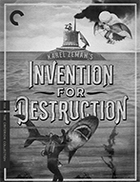Invention for Destruction (Vynález zkázy) [Blu-Ray]
|

Karel Zeman's Invention for Destruction (Vynález zkázy) is a genuine cinematic marvel, a masterpiece of ingenious visual realization in which the screen is transformed into a living, breathing Victorian picturebook. Zeman was a lifelong fan of the 19th-century science fiction and adventure novelist Jules Verne, whose writings about magnificent flying contraptions, underwater vessels, and journeys to the center of the earth was fuel for the imaginations of millions (Verne is second only to Shakespeare and Agatha Christie as the most translated author in the world). Zeman's previous feature, Journey to the Beginning of Time (Cesta do praveku), had been inspired by Verne's writing, but only indirectly. Invention for Destruction, on the other hand, was Zeman's attempt to truly bring Vernes's writing to cinematic life via the woodcut and steel line engravings by Édouard Riou and Léon Benett, the latter of whom illustrated 25 of the 54 novels in Vernes's Voyages Extraordinaires series. The film was a hit both commercially—it is still considered to be the most financially successful Czech film released in the West—and critically. It played at numerous film festivals, including the Brussels International Film Festival, where it won the Grand Prix, and it was praised in the pages of the preeminent French film journal Cahiers du cinéma by no less than André Bazin and future French New Wave director Alain Resnais, who named it one of the ten best films of the year. Zeman and his co-scenarist, the poet and playwright Frantisek HrubÃn, drew on a number of Verne's novels, using a number of the characters and the general plotline from Facing the Flag (1896) while also pulling ideas and motifs from Twenty Thousand Leagues Under the Sea (1870) and Robur the Conqueror (1886). As the film's U.S. release title, The Fabulous World of Jules Verne, suggests, Invention for Destruction is a kind of one-stop homage to all things Verne—not just his fantastical Victorian-era inventions like impossible airships and deep-diving submarines, but also his concerns with technology and the dangers they might pose in the wrong hands. The plot of the film, which is recounted by an engineer named Simon Hart (Lubor TokoÅ¡), involves the brilliant, but naïve Professor Roch (ArnoÅ¡t Navrátil), who is kidnapped by the wealthy Count Artigas (Miloslav Holub). Count Artigas wants to enable Professor Roch to complete his research for a massive new and incredibly powerful invention that Roch imagines will be a help to humankind, but Artigas sees as a world-dominating new weapon. Thus, the story hinges on control of a new technology that could either benefit or destroy humanity, an idea that had particular urgency in the increasing heat of the atomic age. Zeman's film is hardly heavy-handed or didactic, though; rather, it is light and playful, joyous and funny in its evocation of various technologies that Verne had envisioned a century earlier. Invention for Destruction is filled with all kinds of glorious contraptions and modes of transport. One of the most notable is a massive submarine that Count Artigas uses as a weapon to sink ships, after which he employs a gang of surly pirates led by the Pirate Captain (FrantiÅ¡ek Å légr) to plunder their riches. There is a funny-evocative underwater sequence in which the pirates travel to a recently sunk ship on underwater bicycles that still have the traditional bike bell on them. Much of the film transpires in Artigas's secret lair, which is hidden inside a volcanic island and can only be accessed from underwater—a kind of pre-James Bond world of fantastical villainy. The film finds its greatest achievement, though, in its unique visual presentation, which mimics the engraved line drawings that adorned Vernes's novels. Zeman and his dedicated crew of craftsmen evokes this imagery in multiple ways, everything from painting lines on the sets and costumes, to printing certain scenes through lined filters. An animator by trade, Zeman pulls out all the stops, giving us puppetry, stop-motion animation, cut-out animation, and miniature effects. He moves us seamlessly between live action and animation and often combines the two modes, which gives the film an epic, expansive feel that in no way contradicts its quaint, old-school craft that would feel right at home in a silent Georges Méliès film from the turn of the century. Zeman's use of matte-paintings, cutouts, staged backgrounds, and highly stylized sets gives the film the giddy sense of a dream, in which a book's illustrations have magically come to life. It is an intoxicating concoction.
Copyright © 2020 James Kendrick Thoughts? E-mail James Kendrick All images copyright © The Criterion Collection | |||||||||||||||||||||||||||||||
Overall Rating:



 (3.5)
(3.5)
Subscribe and Follow
Get a daily dose of Africa Leader news through our daily email, its complimentary and keeps you fully up to date with world and business news as well.
News RELEASES
Publish news of your business, community or sports group, personnel appointments, major event and more by submitting a news release to Africa Leader.
More Information

 Invention for Destruction is available as part of The Criterion Collection's "Three Fantastic Journeys by Karel Zeman" boxset, which also includes Journey to the Beginning of Time (1955) and The Fabulous Baron Munchausen (1962).
Invention for Destruction is available as part of The Criterion Collection's "Three Fantastic Journeys by Karel Zeman" boxset, which also includes Journey to the Beginning of Time (1955) and The Fabulous Baron Munchausen (1962).